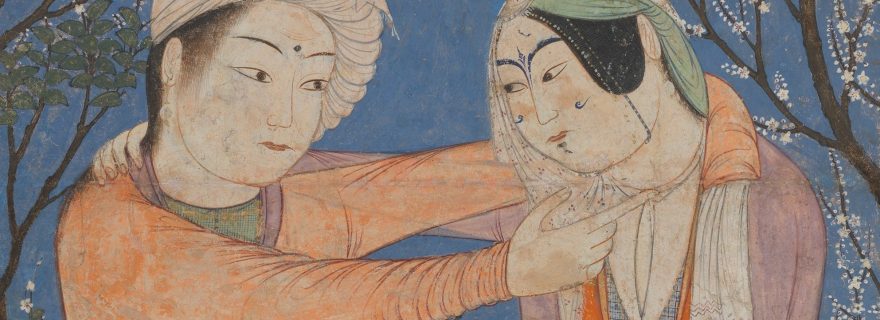Hair and poetry
Asked to identify Muslims, many of us today are likely to envision women with headscarves and men with beards. However, dressing and grooming practices pertaining to hair in the Muslim world show a dazzling variety, vividly described in classical poetry.
Surveying Islamic ideas and practices over the course of history, hair is implicated in matters far beyond the assertion of difference through outward appearance. Hair is especially open to interpretation because of its easy and varied pliability. Through processes of display, hiding, cutting, shaving, binding, braiding, and letting loose, hair is subject to manipulation more than any other part of the physical body. And materiality is just the beginning of the matter in that handling physical hair links to cosmological and metaphorical play concerning all manner of ideals and experiences.
One major arena to see the range of possibilities regarding hair is to attend to its uses in poetic expression. Readers familiar with classical poetry in Arabic, Persian, Turkish, Urdu, and so on, can easily recall examples in which references to hair carry the main burden of what a poet wishes to convey. Sharaf al-Dīn Rāmī’s Persian work A Companion for Lovers (Anīs al-ʿushshāq), composed around 1350 CE in Iran, provides a highly condensed view into this topic. The work’s name refers to Rāmī’s intention to provide lovers with a handy guide for describing their beloveds’ bodily forms within idioms of Persian and Arabic poetry. He divides the human body (without gender distinction) into nineteen different foci of elaboration that range from the head to the feet. Of these nineteen, four are concerned with hair: hair on the head, eyebrows, eyelashes, and fine down on cheeks.
Hair on the head is, per Rāmī, the ‘king of beauty’, the paramount entity that marks the beloved as a beautiful being. Divided between knotted (Turks), curled (people from the Daylam region), or chained (Blacks), it signifies ethnicity. Different words for its length indicate the way it hangs next to the face, hugs the neck, is tucked behind the ear, touches shoulders, hangs down the back, and reaches the feet. Its appearance activates similitude pertaining to color, shape, and smell: amber-like in blackness, akin to bunches of grapes hanging on vines, and redolent like an intoxicating garden.
Hair surrounding the eyes—eyebrows and eyelashes—provides further possibilities for poetic musing. The eyebrow is a niche, the ‘doorkeeper’ that creates the frame for the gaze that connects lovers and beloveds. It is likened to a new moon, the rainbow, the bow from which glances are shot, the curved polo stick to be used in games of love, and the Arabic letters nūn and kāf that turn the face into a readable page. Eyelashes are likened to sharp weapons such as daggers and scalpels. They are a trap with teeth that snaps on prey, or are like rows of protecting soldiers, or the feet of a spider, or sharp points of pens that generate the back and forth of retorts between lover and beloved. Downy hair on cheeks focuses such similes on the mouth. It is fuzz around the lips that look like a half-open pistachio nut, it is the vegetation that encircles a hidden trap, and it carries smells of musk, ambergris, and flowers that enchant lovers.
How should we understand these elaborate and colorful references to hair in poetry? Rāmī’s summaries can be fleshed out through myriads of examples; they provide us a sense for poetry and subsidiary genres, such as painting, as fields of discursive invention and hyperbole. Poetry shows us hair’s role as a mediator of human relations. Hair provides ways for people to project themselves in the world and become objects of the gaze of others. Hair is implicated in processes of attraction and repulsion, matters that bring people together or drive them apart. Poetic use of hair forms a window onto nuances of managing intimate relations in societies where such poetry holds value.
Whereas it is impossible to define an ‘Islamic’ perspective on hair, the topic of hair can be studied to get a deeper understanding and appreciation of the complexity and diversity of Muslim ways of being and knowing. In doing so, Muslims appear to be hardly unique when it comes to making hair ‘meaningful’; the issue is universal to all human groups. Ultimately, hair is a metonym for the human body as such, an object in the world that is, simultaneously, a primary physical and metaphorical instrument that people use to map and navigate the physical and social cosmos.
Shahzad Bashir participated in "On the Meanings of Hair in Medieval Islam", a workshop organized by the Leiden University Centre for the Study of Islam and Society (LUCIS) at Leiden University on 9 and 10 December 2016.
Image: Detail of "Princely Couple". Illustrated Single Work. Cora Timken Burnett Collection of Persian Miniatures and Other Persian Art Objects, Bequest of Cora Timken Burnett, 1956. Met Museum, accession number: 57.51.20. http://www.metmuseum.org/art/collection/search/451399.



0 Comments